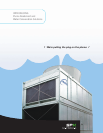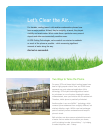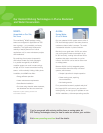
If you’re concerned with reducing visible plume or saving water, let
SPX Cooling Technologies show you how to make our solution, your solution.
Visit www.spxcooling.com/clear for all the details.
Our Hardest Working Technologies in Plume Abatement
and Water Conservation
NCWD:
Assembled on Our Site,
Not Yours
The new Marley
®
NCWD package cooling
towers are configured for applications of 500
tons or greater – yet, remarkably, are factory
assembled. This significantly broadens the
usability of wet/dry towers from “critical
applications only” to more mainstream projects
and installations.
By combining direct contact (evaporative)
and indirect contact (dry) heat exchangers
in a parallel arrangement, the NCWD’s
crossflow system can result in water savings
as high as 20%* versus conventional cooling
towers – while markedly limiting visible plume.
In addition, the NCWD line offers:
• Energy-efficient operation
• Lower maintenance requirements
• Cost-effective installation
• For those using chemical water treatment,
less blowdown and thus less chemicals
Air2Air:
Saving Water,
A Lot of Water
Our new, patented Air2Air system uses a series of
PVC heat exchanger packs in the tower plenum to
condense moisture before it escapes. The result:
A substantial reduction in plume emission.
But there’s more good news. Air2Air can reduce
your cooling tower’s water consumption by up
to 30% annually*, making it the obvious choice
anywhere that water conservation is a prime
concern. And Air2Air can be used on either new
or existing towers.
Because Air2Air is a fully integrated system,
it’s more reliable than exclusively coil-based
systems, which means:
• Simpler hydraulics for simpler operation
• Fewer moving parts, requiring
less maintenance
• No freezing worries
For a personalized economic payback analysis of
the impact Air2Air can have on your planned or
existing facility, and to sign up for updates on new
Air2Air installations, visit www.spxcooling.com/a2a.
* Dependent on system operating conditions and
local weather conditions.






